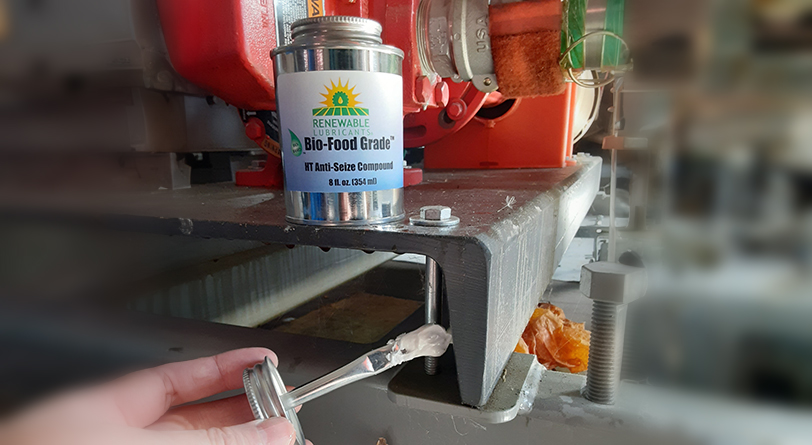Ever since companies began developing alternatives to traditional lubes and greases, there has been confusion over the terms “environmentally friendly” and “biodegradable.” The U.S. Environmental Protection Agency (EPA) defines environmentally acceptable lubricants (EAL) based on three criteria: biodegradability, toxicity to marine and aquatic life, and bioaccumulation. We’ll investigate each of these and look at some practical aspects that using bio-based lubricants can offer for packaging companies.
Base oils
Base oils are a major factor in determining whether a hydraulic fluid meets the EAL standard. Bio-based products, especially those made from vegetable oils, are inherently safer for the environment than petroleum-based products, which is one reason for their increasing popularity. Formulations can also be made with vegetable-based oils that are further processed into a biosynthetic. This enhances their lubricity and protective properties, allowing them to perform as well as or better than their petroleum-based counterparts. They are designed to work in high- and low-pressure hydraulic systems that require anti-wear, anti-rust, anti-oxidation, anti-foam, and demulsibility properties.
Biodegradable
Biodegradability is broken down into two classes—readily biodegradable and inherently biodegradable—based on how much of the product breaks down within a set time frame. Readily biodegradable products break down by 60% or more within a 28-day period. If products do not meet this criterion—if they fall between 20% and 59% within 28 days, for example—then they are classified as inherently biodegradable.
Most industrial applications strive for readily biodegradable products, but the classifications are not well understood or explained. Some inherently biodegradable products are merely marked “biodegradable” without explanation. When in doubt, ask for the details from the manufacturer or distribution channel partner before specifying a product based on its biodegradability. (Bio-Food Grade™ Hydraulic Fluids are readily biodegradable.)
Toxicity
EPA and the U.S. Fish and Wildlife Service base toxicity on how much of a chemical—with concentrations measured in parts per million—is present before it becomes harmful to plants (algae) and fish. Each have different values. For acute toxicity for algae, the maximal effective concentration (EC50) in a test substance is the concentration that results in a 50% reduction in either growth or growth rate relative to the control within 72 hours of exposure, according to ChemSafetyPro, a group of chemical regulatory experts that provide chemical compliance information and safety requirements for products and businesses.
The acute toxicity of fish is expressed as the median lethal concentration (LC50), where the concentration in water kills 50% of a test batch of fish within 96 hours of continuous exposure.
With oxidation performance comparable to full synthetics, in addition to their biodegradability and low toxicity, bio-based, food-grade hydraulic fluids are among the safest and highest-performing hydraulic fluids available.
In addition to their use on food processing and packaging equipment, bio-based food-grade hydraulic fluids are ideal for use in environmentally sensitive areas such as marine environments, fishing vessels, and agriculture, including around farms and processing facilities.
Bioaccumulation
Bioaccumulation is the buildup of foreign chemicals within the tissues of living organisms over time. Heavy metals like zinc and cadmium either do not break down or do so very slowly. When they enter a water source, they are ingested by smaller fish, which are food sources for larger fish, which are food sources for humans.
Renewable Lubricants products are formulated with no zinc or other heavy metals, so there are no bioaccumulation worries.
Practical considerations
Perhaps most importantly, in addition to enhanced performance, Renewable Lubricants bio-based products are odorless and tasteless, so there is no chance of transferring those odors or tastes to the food being packaged, thus safeguarding the brand.
Since they are made from products generally regarded as safe and contain no volatile organic compounds, bio-based greases and hydraulic fluids are safe for the environment and the employees handling them and working near them. Petroleum-based products can be caustic and harmful if they come in contact with the skin, whereas bio-based products generally pose no problems with incidental skin contact.
Petroleum-based products have a much lower flash point, so if they are used near hot running machinery, they pose more of a fire hazard. Bio-based products tend to have significantly higher flash points (often 200 degrees or higher), greatly reducing the risk of a fire.
In addition to the everyday operation of equipment like form-fill-seal machinery, blister packaging, palletizers, and other hydraulic packaging equipment, consider the occasional use of maintenance items like air tools. Most air tools exhaust a fine mist of oil into the atmosphere. If that is bio-based, it poses no health problems to nearby employees. The same cannot be said of petroleum-based hydraulic fluids.
Incidental contact when filling or changing fluids is one thing. Cleaning a spill and disposing of the materials are other matters entirely, and another area where bio-based products make life simpler. Petroleum-based product spills require reporting and may lead to fines being levied. If bio-based materials are spilled, there is no punitive aspect.
If you are planning or hoping to ship your packaged products to Europe, you’ll need to be aware of mineral oil aromatic hydrocarbons regulations that may come into play.
Bio-based lubricants have made significant progress over the past several decades in their performance. That has led directly to their breadth of product availability. With many products available from many manufacturers, there is no shortage of opportunities to enhance your packaging operations’ sustainability.
However, all bio-based lubricants are not the same. Check the manufacturer’s performance specs, get references, and sample the product. If you are in doubt, ask the manufacturer for help. While it may be your first time specifying a bio-based lubricant, it is not the manufacturer’s first time helping a customer make the switch.
Ben Garmier is vice president of Renewable Lubricants Inc., which began as a research and development company in 1991. The company now has more than 250 products and more than 100 worldwide patents.
